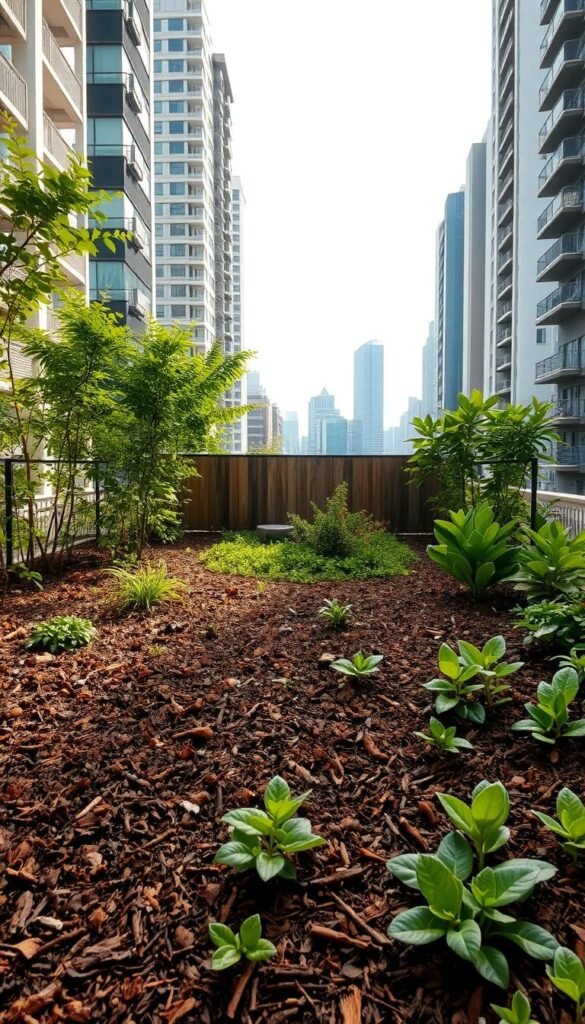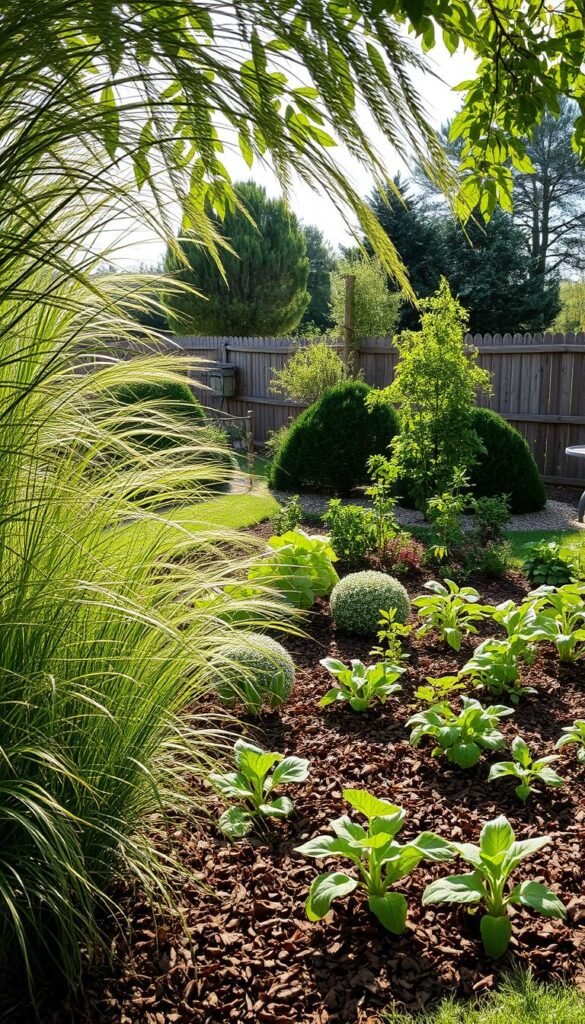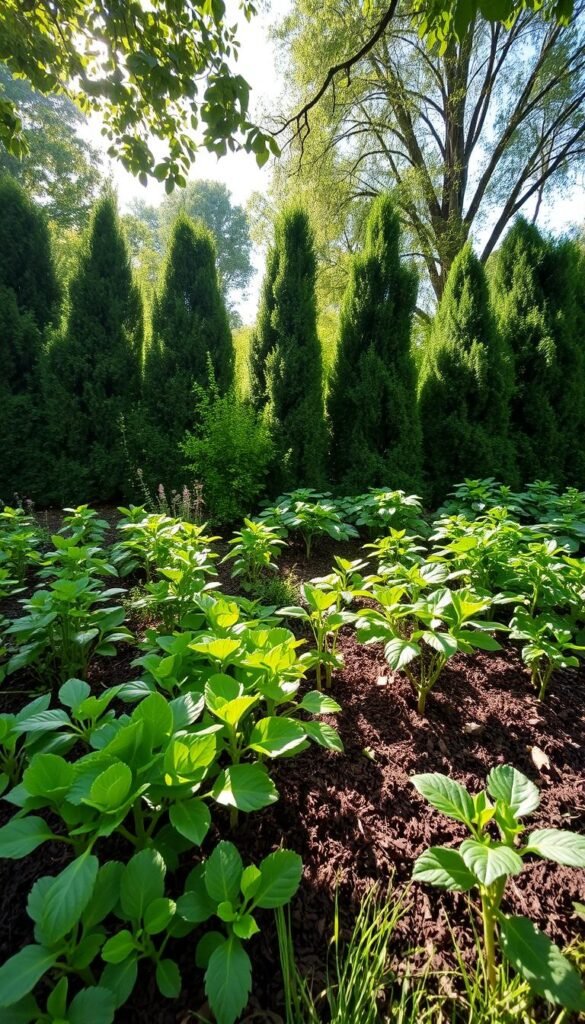Did you know your backyard holds hidden pockets of unique weather patterns? These localized areas, called microclimates, can transform how your garden grows. By understanding these small-scale climate zones, you unlock opportunities to nurture plants that might otherwise struggle in your region.
Your property already has natural variations you can use. Sun-baked pavement edges stay warmer at night, while shaded tree bases remain cooler. Recognizing these spots helps you match plants to their ideal conditions. But you’re not limited to what nature provides—strategic changes can craft new growing environments.
Two powerful tools stand out for shaping these zones. Wind barriers like shrubs or fences shield delicate greens from damaging gusts. Organic ground covers maintain soil moisture and temperature stability. Together, they create protective bubbles that boost survival rates and yields.
These methods work for any space, from balcony pots to acre-sized plots. You’ll soon notice healthier growth, extended harvests, and even success with species labeled “unsuitable” for your area. Best of all, these solutions use affordable materials you might already have.
Ready to turn weather challenges into advantages? Let’s explore how simple adjustments can make your garden more resilient and productive year-round.
Understanding Microclimates in Your Garden

Ever notice how some spots in your yard feel warmer or cooler than others? These pockets form microclimates—small zones where temperature, moisture, and airflow differ from surrounding areas. Learning to spot them helps you work with nature’s hidden design.
What Is a Microclimate?
Picture resting under a maple tree on a sweltering afternoon. The shaded area stays 10°F cooler than your sun-baked driveway. That’s a classic microclimate—a localized environment shaped by shade, surface materials, and topography.
Spotting Climate Variations
Urban spaces bake hotter than rural ones. Pavement and buildings absorb daytime heat, releasing it at night. This “urban island” effect lets you grow figs or citrus where winters usually forbid them.
Your soil type also plays climate-maker. Clay holds moisture, boosting humidity near the ground. Sandy earth drains fast, creating drier conditions. Check this comparison:
| Soil Type | Moisture Retention | Air Temperature Impact |
|---|---|---|
| Clay | High | Cooler, humid |
| Sandy | Low | Warmer, dry |
Slopes reshape climates too. South-facing hillsides get 30% more sun in winter—perfect for early spring crops. North-facing zones stay damp and shaded, ideal for ferns or hostas.
Even small features matter. A stone wall reflects warmth onto nearby plants, while a pond cools summer air. Track these variations through seasons—your fallow winter garden has different microclimates than your lush July yard.
Essential Elements for Building Ideal Garden Conditions

What transforms ordinary dirt into a plant paradise? Four key factors work together: sun exposure, water flow, wind movement, and heat-storing elements. Mastering these lets you craft perfect growing zones, even in tricky spaces like urban balconies.
Assessing Sunlight, Water, and Airflow Patterns
Track sunlight like a detective. Morning rays differ from afternoon beams—some areas get gentle light while others bake. Use this simple guide:
| Sun Type | Best For | Watch Out |
|---|---|---|
| Morning | Cool-season crops | Frost-sensitive plants |
| Afternoon | Heat-lovers | Leaf scorch |
Water behaves like a shy guest—it pools in low spots and avoids slopes. Check where puddles linger after rain. Wind tells its own story: gusty zones need shelter, while still areas risk mold. Listen to rustling leaves—they reveal airflow secrets.
Identifying Natural Features and Existing Microclimates
Your yard already has climate helpers. Mature trees cast shifting shade patterns. South-facing walls radiate warmth at night. Even slopes matter—they channel water and sunlight differently. Look for these heat traps:
| Feature | Winter Effect | Summer Bonus |
|---|---|---|
| Stone wall | +5°F warmth | Shade creation |
| Pond | Frost buffer | Cooling mist |
Draw a simple map marking sunny patches, wind tunnels, and damp zones. This becomes your cheat sheet for placing plants where they’ll thrive naturally. Remember—every garden has unique weather secrets waiting to be used!
Creating a Microclimate: Protecting Plants with Windbreaks and Mulch

Imagine turning gusty garden corners into thriving plant havens. Strategic barriers and ground covers work like invisible armor for your greenery. Windbreaks cut wind speed by 50% while letting gentle breezes nourish plants, preventing the stunted growth caused by harsh gusts.
Living fences made of arborvitae or holly offer year-round protection. For quick solutions, try bamboo screens or trellises draped with vines. These barriers reduce moisture loss from soil and leaves—a common issue in exposed areas that even impacts small-space gardens.
Mulch acts as your soil’s thermostat. A 3-inch layer of straw keeps roots 10°F warmer in spring. Dark wood chips absorb sunlight, warming cold zones. Light-colored stone reflects heat in scorching areas. Both methods prevent rapid temperature swings that stress plants.
Pair these tools for amplified results:
- Windbreaks anchor mulch during storms
- Mulch feeds soil nutrients to barrier plants
- Together, they create 30% more stable growing conditions
You’ll notice changes within weeks—less leaf curling from dry wind, steadier growth patterns, and fewer cracked soil surfaces. Even tender seedlings thrive when sheltered by this dynamic duo.
Implementing Windbreaks and Mulch Strategies

Transform your garden’s exposed areas into sheltered growing spaces using nature-inspired solutions. Strategic plant placement and ground protection work together to buffer delicate greens from harsh elements while boosting soil health.
Selecting and Planting Effective Windbreaks
Start with windbreaks that match your space and style. A mix of berry bushes and ornamental grasses creates living walls that filter gusts while providing food and habitat. Evergreen trees like juniper offer year-round protection, while deciduous varieties allow winter sunlight.
Position barriers 10-15 feet from vulnerable plants—roughly 3 times their mature height. This spacing reduces wind speed by 60% without creating stagnant air pockets. For quick results, pair temporary burlap screens with young shrubs until they establish.
Mulching Techniques to Enhance Soil Moisture and Temperature
Choose mulch types based on your goals. Straw or wood chips keep soil moist and cool in summer, while black plastic warms spring beds for tomatoes and peppers. Light-colored stone reflects heat in scorching zones.
Apply a 3-inch layer around plants, leaving space near stems to prevent rot. Replenish organic options as they break down—this feeds earthworms and improves soil structure. Pair with windbreaks to prevent mulch displacement during storms.
“The right combination cuts watering needs by half,” notes a USDA study on sustainable gardening. Test different materials to find what stabilizes your garden’s temperature and moisture levels best.
Integrating Soil, Water, and Thermal Mass for Enhanced Growth
Your garden’s secret weapon isn’t just what you plant—it’s how you shape their environment. By balancing soil quality, water management, and heat-retaining elements, you create a powerhouse system that fuels plant health and stretches your growing season.
Modifying Soil Conditions with Amendments and Mulch
Clay or sandy soil? Organic fixes like compost boost water retention in dry areas, while peat moss improves drainage in heavy earth. Dark mulch absorbs daytime heat, warming roots at night—perfect for tomatoes or peppers. Light-colored stone reflects sunlight in hot zones, keeping greens cool.
Utilizing Thermal Mass: Ponds, Walls, and Raised Beds
Stone walls and raised beds act as nature’s batteries. They soak up daytime warmth, releasing it after sunset to shield plants from frost. Water barrels near tomatoes can raise nighttime temps by 5°F—enough to save tender crops.
Extending the Growing Season with Strategic Modifications
Dark containers or soil amendments let you harvest weeks longer. Raised beds warm faster in spring, letting you plant lettuce earlier. Pair these with windbreaks, and you’ll protect blooms from late frosts while conserving moisture.






